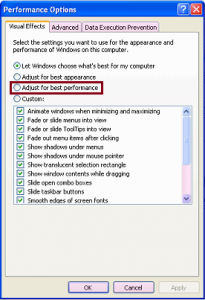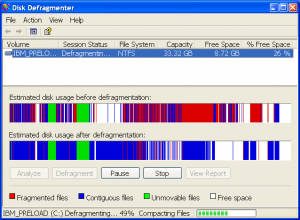Step 1 : Remove unused software
You probably don’t use half the programs you have installed over time. Removing the ones you don’t need anymore can significantly speed up your Windows XP computer. To remove software:
- Go to the Control Panel (Start -> Control Panel) and select Add Or Remove Programs. It may take a while for the list to load if you have many programs installed.
- Going through the whole list, select programs you rarely use and uninstall them, one by one.
- Restart your computer to see the changes.
Step 2: Use Less Graphics
Do you really need a wallpaper and the fancy animations when opening or closing windows? Disabling animations can increase the speed at which your computer opens and closes windows. To disable window animations:
- In Control Panel, go to System and select the Advanced tab. Click the Performance Settings tab.
- In the Visual Effects window, disable all the animations in the box, or simply select “Adjust for best performance” as shown on the screenshot on the right. Press Apply.
In the same Performance Options window, choose the Advanced tab, and press the Change button in the Virtual Memory area. From there you can change the size of your paging file – a file on your hard drive that acts as RAM. By increasing the size of your paging file, you can significantly increase speed, but be warned! Using your hard drive as RAM can cause damage to it, so it’s a good idea to buy a better RAM instead.
Step 3: Clean your Registry
You should regularly clean your Windows XP’s Registry to remove old errors that can clog up the registry. To properly clean the Registry, you need a reliable Registry Cleaner software. There are some free ones out there
Step 4: Stop unwanted Startup programs
By disabling programs that are set to automatically open when the computer starts, you can greatly speed up your startup process – the time between turning on the computer and being able to fully use it.
Here’s how to disable Startup programs:
- Click Run in your Start menu, type msconfig into the box and press enter.
- Select the Startup tab.
- Go through the list, disabling programs you don’t need by un-ticking the box left of them. Only disable programs you are sure you do not need, and I recommend not touching the ones in the WINDOWS directory.
Step 5: Clean up your hard drive
Performing a disk cleanup can free some hard drive space and also speed up your computer. To use the disk cleanup tool:
- Go to Start -> Run and type cleanmgr.exe. Press Enter.
- It will probably take a while, especially if you have never used this tool before.
Step 6: Defragment your hard drives
Defragmenting your drives can make a big difference in your computer’s speed. Defragmenting places files physically closer on the hard drive, making it easier and faster for the hard drive to read these files and write new ones. It is a good idea to defragment your hard drive regularily, so it alway stays optimal.

- In My Computer, right click on a drive you want to defragment.
- Click Tools and select Defragment
- Click the Analyse button first, which will analyse your hard drive and see how fragmented it is.
- Once the report is finished and the system finds it necessary to perform a defragmentation, press defrag. This will take a very long time, but you have to be patient.
*Please Use This Under Expert Advice or Observation Eas Consultants or Xtream Art Not Responsible For Any Damage
Contact Us: eas_Consultant @ yahoo.com



 CAclubindia
CAclubindia
